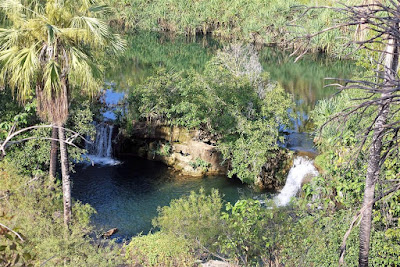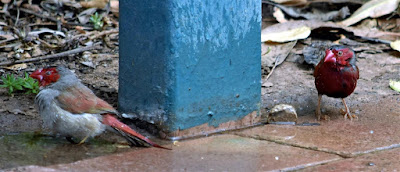27 – September 2016 - 17/9/16
Leaving Tennant Creek early in the morning we had a very big
day driving, changing drivers around every 1 ½ hours (which included a stop
with a little siesta in the caravan) and we made our way to Camooweal,
Queensland a distance of about 450 kilometres. The day’s drive was along reasonably
flat terrain with a bit of bush either side of the road, cattle grazing in the
occasional paddock, otherwise there wasn’t much scenery to view along the
route. We were well and truly over driving by the time we arrived at Camooweal.
There were a couple of caravan parks in the town but we
chose to camp just out of town at a beautiful waterhole, Lake Francis with
plenty of bird life to view in a non-commercialised, non-cost location.
We devoted plenty of time for pleasurable activities,
recovering from our long drive which included various conversations with other
travellers with the added bonus, obtaining information about road conditions
and locations we were hoping to visit along our planned route. We continued
with the revitalization of our tired bodies spending copious amounts of time resting,
watching pelicans, darters, spoonbills and brolgas intermingling along the
waterhole from our camp site.
One day we walked into town to assess what was on offer
which turned out not to be of much interest for us.
 |
| Drover tribute painting |
One evening at sunset some light rain appeared helping to
create a beautiful sunset.
Two nights at Camooweal turned into four nights due to the
beautiful location and our footy team were playing in one of the end of season
finals. We had some unexpected phone reception at Camooweal and Mary just had
to stay put to watch the game via the phone as we didn’t have any TV reception.
We left Camooweal in a delighted state of mind, being woken
at 6 am the second morning in a row by nearby Brolgas’, with their high pitched
‘ga-r-r-oo’ call and our footy team had won their football match to play
another day positioning themselves closer towards a grand final berth.
It was another long day seated in the saddle of the tow tug idling
slowly along some rough roads. The scenery was pleasant with a red rocky base
sparsely covered by spinifex grass and a mixture of pine and gum trees.
Complementing the setting we saw emus, cattle and four pair of eagles
emphasising the beautiful rugged Australian outback setting.
 |
| A cuppa break |
We always slow when approaching stock near the side of the
road and on this occasion we were so glad that we were able to stop as this
animal stepped straight out into the middle of the road blocking our passage.
At one stage we came across another stopped caravan that had
passed us earlier. We stopped to check
on their welfare and it seemed that they were unable to continue with their
planned holiday at Lawn Hill National Park as their caravans main water tank
had broken away spilling its contents. They were in need of repairs only
available at a largish town probably at Mt Isa a couple of hundred kilometres
away in the opposite direction.
 |
| Water tank at 45 degrees under van in contact with ground |
Their unfortunate predicament was a timely reminder for us -
we were travelling in remote rugged locations where we needed to consider our
options for survival. Our first priority for survival was to carry an
appropriate amount of water and food. And to have on hand a backup supply in
case a, “what if” occurred. (Unbeknown to us we were soon to experience a “what
if” further along in this area.) Part of the survival package is consideration
for your equipment that we rely on so significantly and we rarely give our
equipment much thought. For us that equates to utilising the heaviest duty
equipment that you deem appropriate and you think your budget can afford. When
travelling along the Australian rugged outback roads, most usually in poor
condition, comprising of dirt, gravel, stone or sandy surface we always travel
at a slow rate, taking our time, looking after our rig and our bodies. And even
then our caravan and tow tug still require regular maintenance.
We crossed a floodway at the flowing Gregory River after
selecting 4wd for maximum traction before stopping for the night about 500
metres up the road at the Lawn Hill National Park - Miyumba camping area. It
was a very small camping area with our targeted camp ground still another 60
kilometres away. We walked into the fast flowing water at the vehicle crossing
and nearly had our feet swept out from under us by the force of the water,
still a few metres shy from where the full force was flowing through. The
campground was very quiet, having it all to ourselves with the constant noise
of flowing water and bird chatter in the background.
We continued inland with a stop to explore the World
Heritage Listed Riversleigh Mammal Fossil Site. There was a manmade cave with
plenty of explanatory information about the planets evolution and a walking
path with interpretive signage pointing out various fossils imbedded in the
nearby rocks. It was all reminisant of materials and information normally found
in air-conditioned museums, not in the dry dusty outback, in very hot 38 C
temperatures (this day’s temperature) with the added authentic bonus of plenty
of annoying flies.
 |
| Driving in outback Australia |
Our next planned nights stop didn’t come to fruition (camping
area closed) and we continued on to the Lawn Hill National Park camping ground where
we were lucky enough to secure a campsite 2 days prior to our original booked
date.
Our first priority was to immerse our bodies into the cool
emerald green waters of Lawn Hill Gorge which had been formed by the Lawn Hill
Creek, fed by numerous freshwater springs. It was certainly a great setting, an
oasis seemingly appearing from out of the ground in a reasonably flat barren
landscape.
We initially spent a lot of time in the water with the caravan
thermometer showing a steady 38 degree temperature each day for several hours
during our first 3 days at Lawn Hill. It did feel hot including the nights.
One of the activities available at Lawn Hill was canoe hire.
We paddled one of these canoes along Lawn Hill Creek viewing its magnificent wet
riverine forest fringes and some impressive red-brown rock gorges. It was a 6 kilometres,
3 hour paddle for us where we were constantly mesmerised by the scenery.
 |
| Indarri Falls |
 |
| Indarri Falls |
About a kilometre along the creek you come to Indarri Falls where
you move from the water onto the land, carrying your canoe around the falls to
the upper level where you continue paddling along the creek.
 |
| Indarri Falls |
We paddled as far as the calm waters lasted including rowing
as hard as we could into the final rapids till the flow of the water took hold
of the canoe spinning us around, pushing us back down stream.
The 3 below pictures taken from our canoe trip were at the
location where we swam in the water several times each day, located about 100
metres from our camp site.
There were half a dozen walking tracks accessible from the
camp ground but unfortunately 3 were non-accessible due to maintenance required
on an access platform. We thoroughly enjoyed the walking trails and the magnificent
accompanying scenery.
There was plenty of bird activity along the water way.
Whilst on our canoe trip we saw a juvenile Fairy Martin in the water swimming
towards us being chased by Archer fish. We rescued it with a paddle and it sat there
exhausted. We found a tree near the base of the cliff face below the bird nests
that it probably had fallen from where we left it.
We enjoyed watching the colourful Red Winged Parrots in the
early mornings and evenings.
For us Lawn Hill National Park was a magnificent picturesque
location well worth the effort, travelling to an out of the way location.
Prior travelling to Lawn Hill we had checked the Bureau of Meteorology
7 day weather forecast for this area, resulting with a perfect weather
forecast. After 3 days the clouds started to appear and slowly build up intensity
over the next few days. Luckily we had internet reception where we were able to
monitor the weather forecast and it quickly changed to a forecast of rain and
more rain.
It was 12 days since our last food shop and we didn’t like
the prospect of being stuck at this location for an extended period of time due
to inaccessible roads that can get cut off, washed away, damaged so easily by a
sudden down pour of rain. We decided to err on the side of caution and forfeit
our last 3 days camping fees, leaving early, hopefully avoiding driving on
unsealed roads / tracks in the wet, slipping and sliding, getting horribly
dirty, relocating our travels closer to bitumen sealed roads less likely to be
affected by wet conditions. That was our theory at time of publication prior to
shipping out! We thought this should be close to a “what if” scenario and it
did rain a bit before departure.


















































No comments:
Post a Comment